720 Search Results for model
January 6, 2015
by Carole Zangari -
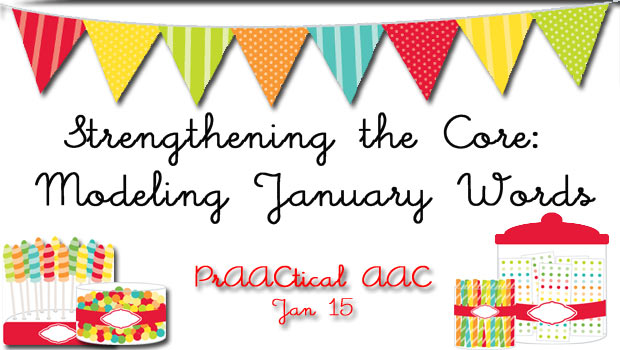
Looking for some ways to help your AAC learners become more competent in using core words? Here’s an approach you may want to try: Keep it manageable by choosing only a dozen or two core words to focus on each month. In previous years, we shared lists of some core words to help you do just that. 2013: A Year of Core (12 words/month) 2014: A(nother) Year of Core (16 words/month; Note: These are different than the core words covered in 2013) Those posts have links to downloadable grids with the core words for each month that can be used as a focal point for lesson planning. Rather than introducing new words at this point, let’s take some time to strengthen our core by modeling the words in everyday interactions. Here are some suggested phrases, sentences, and questions for each of the core words from our 2013 list. Click on the... [Read More...]
April 9, 2014
by Carole Zangari -
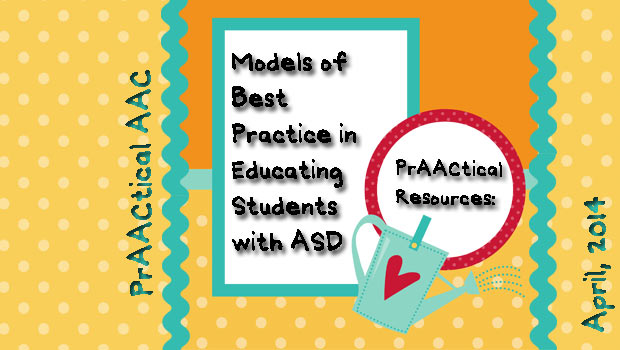
Need information on systematic instruction, Functional Behavior Analysis, or other best practice ideas? This document, by the Virginia Department of Education, is easy to read and covers a great many topics. Take a look.
March 3, 2013
by Carole Zangari -
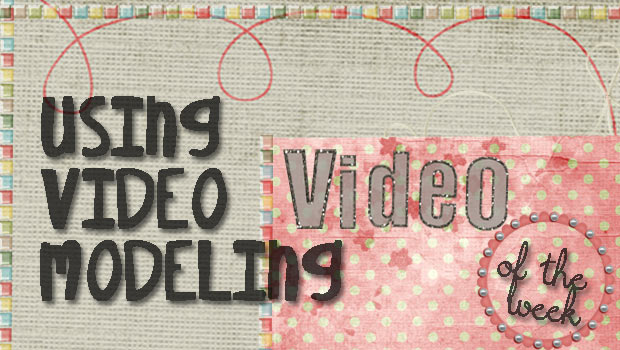
Video modeling is an empirically supported intervention strategy hat more of us could be using in our clinical work. This week we feature some examples of video modeling for some common communication behaviors. We love the fact that these focus on adults. Kudos to the team at Villa Esperanza Speech and Language Center for making and sharing these videos. Asking for a Break Saying Goodbye
January 20, 2013
by Carole Zangari -
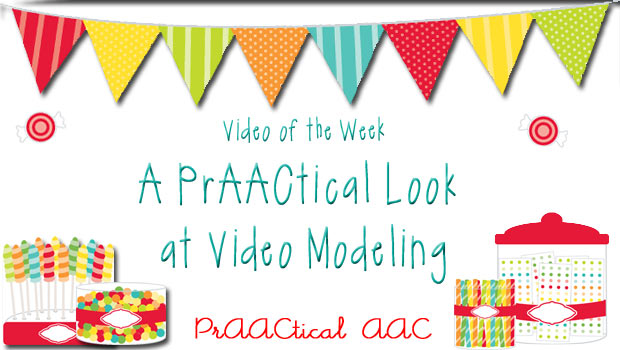
The research base for using video modeling as a tool to help AAC learners understand what to do is well-documented. The folks at SCAAC-N make it look easy! Here are a few that they shared for communicating while doing a job (shredding paper). Asking for ‘more’ Asking for a break Asking for help Want to know more about using video modeling in your own practice? Here’s a great resource document from the National Professional Development Center on ASD. Want more info on how to do this with mobile technology? Tony Gentry from Autism Center at Virginia Commonwealth University explains in this video.
July 15, 2012
by Robin Parker -
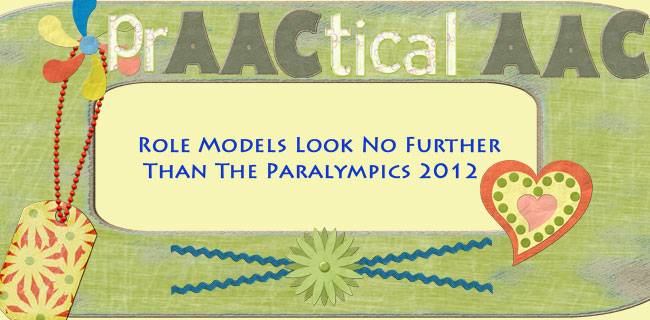
Have you met Mandeville and Wenlock? Think Paralympics and Olympics. These mascots were created by Grant Hunter in collaboration with children. They were made with children in mind to help encourage participation in Paralympic and Olympic sports. We love that Mandeville and Wenlock are encouraging ALL children to aspire to be world-class athletes. Not only are the Olympics a big deal (See our Olympic PrAACtical AAC perspective), but the Paralympics are also a big deal. Paralympic Althletes impress most everyone and provide an opportunity for children with disabilities ALL over the world, to have role models who might look or sound like them. We love it when everyone can be inspired together. The Summer Paralympics will take place in London, England, in 2012, from August 29 through September 9. They will be the biggest Paralympic Games ever featuring 4,200 athletes from 160 countries who will compete in 20 sports. These... [Read More...]
April 18, 2012
by Carole Zangari -
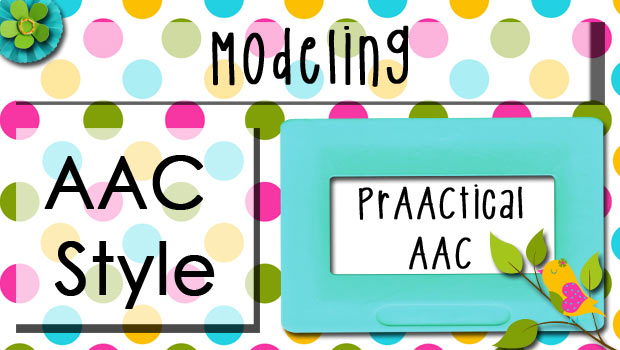
This is a strategy that is too powerful to ignore. Here’s why Aided Language Input is at the top of our list of skills that all clinicians should master. – 1. Helps children and adults learn their AAC faster: There is good research demonstrating how valuable this kind of modeling is for our AAC clients. See studies by Drs. Kathryn Drager, Cathy Binger and Janice Light, Jennifer Kent-Walsh, Shakila Dada and Erna Alant for starters.– 2. Helps the SLP get competent with the client’s AAC system: This is hands-down the quickest way for us to get familiar with our client’s AAC device. – 3. It’s common sense: Think about it: How many times does a typical 1-year old hear the word ‘more’ before she says it?? Don’t AAC kids need that much exposure to ‘their’ language systems?? – 4. Expands our sphere of influence: Other communication partners will imitate us. If WE use it, then parents and teachers are... [Read More...]
April 13, 2025
by Carole Zangari -
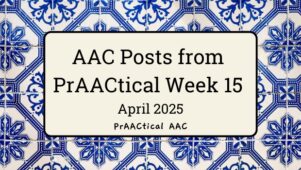
Happy Sunday, AAC friends. We have some posts you might enjoy. Tuesday – AAC Link Up Wednesday – Video of the Week: AAC Tools Explained by Those Who Use Them Thursday – Resource Roundup: AAC-friendly Earth Day Materials Also, if autism is an area of interest, consider joining us at this free webinar by Dr. Petere Vermeulen on Autism & Happiness: From Neurodiversity to Neuroharmony (registration link here). :::::::::::::::::::::::::::::::::::::::::::::::::::::::::::::::::::::::::::::::::::::::::::::::::::::::::::::::::::::::::::::: Have time for a little more browsing? Check out these past posts. When Helping Isn’t Helping-Prompt Awareness in AAC Instruction Administratively Speaking: 5 Considerations for Recruiting and Retaining AAC SLPs AAC In the Classroom: Considerations for Modeling Core Vocabulary How I Do It: A Year of Core Word in Action AAC in the High School Classroom: Where Core Vocabulary Meets Life Skills
March 30, 2025
by Carole Zangari -
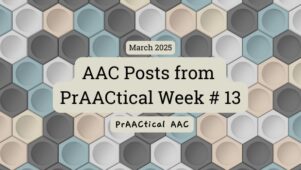
Happy Sunday, AAC friends. Here are some posts you might have missed. Monday – PrAACtical Considerations: Prestored Messages in AAC, Part 2 Tuesday – AAC Link Up Wednesday – Video of the Week: Supporting Part-time AAC Users Thursday – April Year of Core Vocabulary Resources :::::::::::::::::::::::::::::::::::::::::::::::::::::::::::::::::::::::::::::::::::::::: Looking for some resources to use in your AAC work? Check out some of those listed below. AAC 101 Flipbook Communication Partner Data Collection Form AAC Skills: Caught or Taught? AAC Modeling Handout Repairing Communication Breakdowns
March 27, 2025
by Carole Zangari -
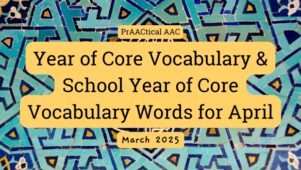
Core vocabulary resources are the focus of today’s post. In 2013, when schools and other clinical programs were expanding their emphasis on teaching core vocabulary words, PrAACtical AAC published a set of resources for families and professionals that included symbol cards, sample sentences to model, activity suggestions, and more. All of these were based on a small set of core words for each month (see that post here). We followed that with a second set of Year of Core Vocabulary Word resources for a new list of words (click here for that post). Over the years, the resources were expanded and grew to include a wonderful series of calendars with daily activity suggestions developed by AAC SLP and co-founder of Talking AAC, Rachael Langley. Many other contributors over the years added to these efforts. In 2020, a new series was launched, School Year of Core Vocabulary Words, authored by guest contributors... [Read More...]
January 6, 2025
by Carole Zangari -
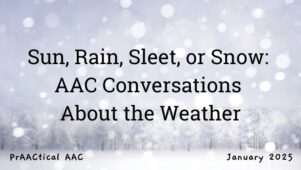
It’s a cold, snowy week in much of the US, and that gives us something fun to talk about. It makes a regular appearance at Circle Time and Morning Meetings. It’s part of our casual conversation on a daily basis. We learn about it in Science classes, and it often plays a role in the books we read. Everyone talks about the weather. How can we take advantage of this ubiquitous topic to strengthen AAC learning? Here are a few ideas of language concepts to address. Core Vocabulary: Weather-related discussions offer many opportunities to model and elicit core words, both by themselves and in the context of longer sentences. Single words: Feel, it, like, look, see, that, what Multi-word combinations: I can see rain/snow/sun. Look at that. What is it like outside? Can you feel it? I don’t like when it is ___. More Advanced Vocabulary: Many AAC users have... [Read More...]









